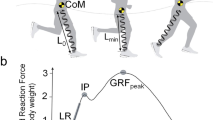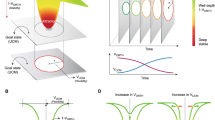Abstract
The response of heel-toe runners to changes in cushioning of the impact interface was investigated. Ground reaction force and sagittal plane kinematic data were collected for six heel-toe runners performing barefoot running trials on a conventional asphalt surface and an asphalt surface with additional cushioning. Statistical analysis indicated that similar peak impact force values were maintained when running on the two surfaces (p < 0.1). When running on the less cushioned surface, significant reductions were detected in ankle dorsi-flexion angle immediately prior to ground impact and peak ankle plantar-flexion velocity immediately following impact (p > 0.1). In addition, individual subjects demonstrated reductions in heel velocity and increases in knee flexion immediately prior to ground contact. The observed reduction in ankle dorsiflexion at impact, resulting in a flatter foot at ground contact, supports previous suggestions that this is a strategy to reduce local plantar pressure loads. The additional use of adjustments in heel velocity and initial knee flexion highlights the ability of some subjects to adopt compensatory measures to reduce peak impact loading. However, some subjects appear unable to make these adjustments, resulting in higher impact loading on the less cushioned surface for these subjects. This study provides experimental evidence to support the theoretical potential of heel impact velocity and initial knee flexion to influence impact loading in running.
Similar content being viewed by others
References
Andreasson, G. and Peterson, L. (1986) Effects of shoe and surface characteristics on lower limb injuries in sports.International Journal of Sports Biomechanics 2, pp. 202–209.
Bates, B.T., Osternig, L.R., Sawhill, J.A. and James, S.L. (1983). An assessment of subject variability, subject-shoe interaction, and the evaluation of running shoes using ground reaction force data.Journal of Biomechanics,16, pp. 181–191.
Bobbert, M.F., Yeadon, M.R. and Nigg, B.M. (1992) Mechanical analysis of the landing phase in heel-toe running.Journal of Biomechanics,25, pp. 223–234.
Clarke, T.E., Frederick, E.C. and Cooper, L.B. (1983) Biomechanical measurement of running shoe cushioning properties. In B.M. Nigg and B.A. Kerr (eds),Biomechanical Aspects of Sport Shoes and Playing Surfaces, Calgary, AB. University of Calgary, pp. 25–33.
Cole, G.K., Nigg, B.M., Fick, G.H. and Morlock, M.M. (1995) Internal loading of the foot and ankle during impact in running.Journal of Applied Biomechanics,11, pp. 25–46.
Denoth, J. (1986) Load on the locomotor system and modelling. In B.M. Nigg (ed.).Biomechanics of running shoes. Champaign, IL. Human Kinetics, pp. 63–116
Derrick, T.R. (2004) The effects of knee contact angle on impact forces and accelerations.Medicine and Science in Sports and Exercise 36, pp. 832–837.
Dixon, S.J. and Kerwin, D.G. (1999) The influence of heel lift manipulation on sagittal plane joint angles in running.Journal of Applied Biomechanics,15, pp. 139–151.
Dixon, S.J., Collop, A.C. and Batt, M.E. (2000) The influence of surface shock absorption on ground reaction forces and kinematics in running.Medicine and Science in Sports and Exercise,32, pp. 1919–1926.
Feehery, R.V. (1986) The biomechanics of running on different surfaces.Sports Medicine,3, pp. 649–659.
Frederick, E.C. (1986) Kinematically mediated effects of sport shoe design: a review.Journal of Sports Sciences,4, pp. 169–184.
Gerritsen, K.G.M., van den Bogert, A.J. and Nigg, B.M. (1995) Direct dynamics simulation of the impact phase in heel-toe running.Journal of Biomechanics,28, pp. 661–668.
Herzog, W. (1978) Masters Thesis, ETH, Zurich. Cited in
Nigg, B.M. and Yeadon, M.R. (1987). Biomechanical aspects of playing surfaces.Journal of Sports Sciences,5, pp. 117–145.
Kinoshita, H., Bates, B.T. and de Vita, P. (1985) Intertrial variability for selected running gait parameters. In D. Winter, R. Norman, R. Wells, K. Hayes and A. Patla. (eds).Biomechanics IX-B, pp. 499–502.
Lafortune, M.A., Hennig, E.M. and Lake, M.J. (1996) Dominant role of interface over knee angle for cushioning impact loading and regulating initial leg stiffness.Journal of Biomechanics,12, pp. 1523–1529.
Liu, W. and Nigg, B.M. (2000) A mechanical model to determine the influence of masses and mass distribution on the impact force during running.Journal of Biomechanics,33, pp. 219–224.
Nigg, B.M. Bahlsen, H.A., Luethi, S.M. and Stokes, S. (1987) The influence of running velocity and midsole hardness on external impact forces in heel-toe running.Journal of Biomechanics,20, pp. 951–959.
Nigg, B.M. and Yeadon, M.R. (1987) Biomechanical aspects of playing surfaces.Journal of Sports Sciences,5, pp. 117–145.
Nigg, B.M. and Bahlsen, H.A. (1988) Influence of heel flare and midsole construction on pronation, supination and impact forces for heel-toe running. InternationalJournal of Sport Biomechanics,4, pp. 205–219.
Perry, S.D. and Lafortune, M.A. (1995) Influences of inversion/eversion of the foot upon impact loading during locomotion.Clinical Biomechanics,10, pp. 253–257.
Snel, J.G., Dellman, N.J., Heerkens, Y.F. and van Ingen Schenau, G.L. (1985) Shock absorbing characteristics of running shoes during actual running. In D.A. Winter, R.W. Norman, R.P. Wells, K.C. Hayes and A.E. Patla. (eds.).Biomechanics IX-B, pp. 133–138.
Wilson, J.F., Rochelle, R.D. and Bischoff, J.E. (1997) Identification and correlation of human footfall load parameters using multivariate analysis.Journal of Biomechanical Engineering,119, pp. 115–123.
De Wit, B., de Clercq, D. and Aerts, P. (2000) Biomechanical analysis of the stance phase during barefoot and shod running.Journal of Biomechanics,33, pp. 269–278.
Author information
Authors and Affiliations
Corresponding author
Rights and permissions
About this article
Cite this article
Dixon, S.J., Collop, A.C. & Batt, M.E. Compensatory adjustments in lower extremity kinematics in response to a reduced cushioning of the impact interface in heel–toe running. Sports Eng 8, 47–55 (2005). https://doi.org/10.1007/BF02844131
Issue Date:
DOI: https://doi.org/10.1007/BF02844131




